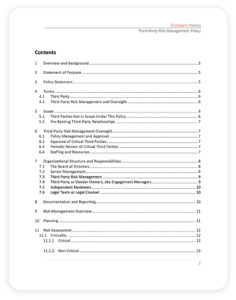Organizations are increasingly relying on third-party service providers to perform various tasks and functions. This reliance introduces new security risks and challenges, as unauthorized access to sensitive data or systems by a third-party service provider can have severe consequences for the organization.
Implementing a robust Third Party Service Provider Security Policy Template is crucial to mitigating these risks. A well-defined policy provides a framework for organizations to assess, select, monitor, and manage third-party service providers effectively. It outlines security requirements, responsibilities, and best practices, ensuring the protection of sensitive data and systems.
Key Elements of a Third-Party Service Provider Security Policy Template
A comprehensive Third Party Service Provider Security Policy Template typically includes the following key elements:
- Risk Assessment and Due Diligence: Organizations must conduct a thorough risk assessment to identify potential vulnerabilities and threats associated with engaging with a third-party service provider. Due diligence should be performed to evaluate the security posture, reputation, and track record of the provider.
- Security Requirements: Clearly defined security requirements that the third-party service provider must meet to ensure the protection of sensitive data and systems. This includes requirements related to data security, access controls, encryption, incident response, and more.
- Responsibilities and Roles: Clearly outlines the roles and responsibilities of both the organization and the third-party service provider in maintaining security. This includes responsibilities for data protection, incident response, security audits, and ongoing monitoring.
- Data Security and Privacy: Specifies the measures to protect sensitive data, including data encryption, data retention policies, and data disposal procedures. It also addresses compliance with relevant data privacy regulations and standards.
- Incident Response and Management: Establishes procedures for handling security incidents involving the third-party service provider. This includes incident reporting, investigation, containment, and recovery processes.
- Monitoring and Audits: Provisions for regular monitoring and audits of the third-party service provider’s security controls and practices. This ensures ongoing compliance with the security policy and identifies potential vulnerabilities.
- Engage Legal and Compliance: Involve legal and compliance teams in the policy development process to ensure alignment with relevant laws, regulations, and industry standards.
- Conduct Regular Reviews and Updates: Regularly review and update the policy to reflect changes in the organization’s security posture, emerging threats, and industry best practices.
- Provide Training and Awareness: Educate employees and stakeholders about the policy’s requirements and their responsibilities in maintaining security when working with third-party service providers.
- Foster Collaboration and Communication: Establish open lines of communication between the organization and third-party service providers to facilitate information sharing, issue resolution, and incident response.
- Continuously Monitor and Evaluate: Continuously monitor and evaluate the effectiveness of the policy by conducting regular audits, reviewing incident reports, and assessing the overall security posture of the organization and its third-party service providers.
Best Practices for Implementing a Third-Party Service Provider Security Policy Template
To ensure the effectiveness of the Third Party Service Provider Security Policy Template, organizations should consider the following best practices:
By implementing a comprehensive Third Party Service Provider Security Policy Template and following best practices, organizations can significantly reduce the risks associated with third-party service providers and protect their sensitive data and systems effectively.
Conclusion
A robust Third Party Service Provider Security Policy Template is a critical element of an organization’s overall security strategy. It provides a structured approach to managing and mitigating risks associated with third-party service providers. Organizations must regularly review, update, and enforce the policy to ensure its effectiveness in protecting sensitive data and systems.
By adopting a proactive stance in managing third-party service provider security, organizations can safeguard their assets, maintain compliance, and minimize the likelihood of security breaches and incidents.
FAQ
What is the purpose of a Third Party Service Provider Security Policy Template?
A Third Party Service Provider Security Policy Template is a document that outlines the security requirements and expectations that an organization has for its third-party service providers. It serves as a framework for assessing, selecting, and managing third-party service providers to ensure the protection of sensitive data and systems.
What are the key elements of a comprehensive Third Party Service Provider Security Policy Template?
Key elements of a comprehensive Third Party Service Provider Security Policy Template typically include risk assessment and due diligence, security requirements, responsibilities and roles, data security and privacy, incident response and management, and monitoring and audits.
What are some best practices for implementing a Third Party Service Provider Security Policy Template?
Best practices for implementing a Third Party Service Provider Security Policy Template include engaging legal and compliance teams, conducting regular reviews and updates, providing training and awareness, fostering collaboration and communication between the organizations and their third-party service providers, and continuously monitoring and evaluating the effectiveness of the policy.
